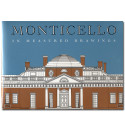The "First Monticello," sometimes called "Monticello I," refers to the house as it existed during the period extending roughly from 1770 to 1796.
Though more modest in size than its successor, the first version of the Monticello house was hardly less ambitious. Built in a strict neoclassical style with double porticoes, it was a building that, as one European visitor wrote in 1782, "resembles none of the others seen in this country."[1]
This was the house that Jefferson was fashioning when he married Martha Wayles Skelton in 1772 and in which they planned to raise their children. During its construction, Jefferson served as a member of the Virginia House of Burgesses in Williamsburg; as a delegate to the Second Continental Congress in Philadelphia; and as Governor of Virginia in Richmond. This was the same period when he wrote the political documents that made his early reputation: A Summary View of the Rights of British America, the Declaration of Independence, and the Virginia Statute for Religious Freedom, which was later enacted into law.
The exact extent to which the house was finished is unclear. The physical and documentary evidence indicates that by the death of Jefferson's wife in 1782, the house had been enclosed. But twelve years later, after serving as the United States Minister to France from 1784 to 1789 and for four years as George Washington's Secretary of State, Jefferson wrote to a friend that he was "living in a brick-kiln," suggesting that much of the interior work had not been started.[2]
Jefferson's years in France marked a radical turning point in the design of the house. Before then, Jefferson's architectural education had been largely through books, including the Four Books of Architecture by sixteenth-century architect Andrea Palladio. In Paris, where Jefferson saw a new style of domestic architecture that was elegant and less academic in its classical form, he began to think about remodeling and enlarging his house from eight to twenty-one rooms. Demolition of the first Monticello, which began in 1796, was limited to its upper floors and northeast front. Much of the original brickwork of the first floor was incorporated in the new house on the southwest side.
 Available in Our Online Shop: Monticello in Measured Drawings
Available in Our Online Shop: Monticello in Measured Drawings
ADDRESS:
931 Thomas Jefferson Parkway
Charlottesville, VA 22902
GENERAL INFORMATION:
(434) 984-9800
